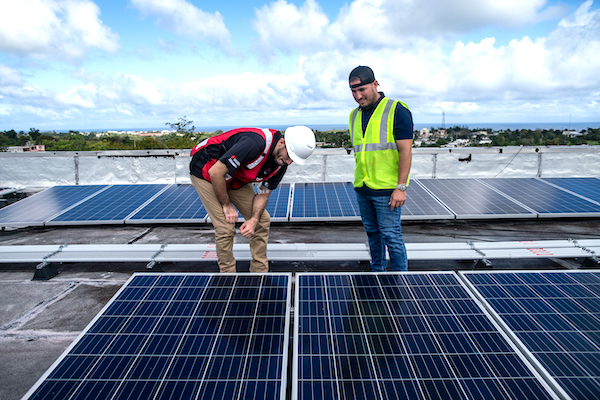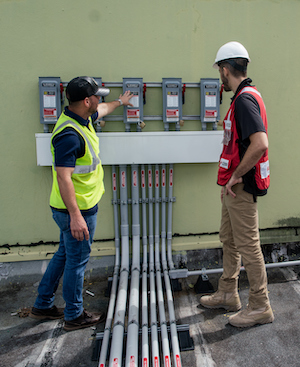The Hidden Truth: Solar assets demand maintenance to shine bright
In the ever-expanding world of clean energy, solar power has emerged as a powerful contender. With millions of solar megawatts operational across North America, the industry has been primarily focused on financing, engineering, system design, and construction. What often gets overlooked, however, is the crucial chapter that unfolds after the ceremonial ribbon cutting: the world of solar maintenance.
Solar maintenance, an integral part of the operations and maintenance (O&M) sector, encompasses a suite of activities that range from preventative and corrective actions to conditional and predictive maintenance. It's the unsung hero that keeps solar assets performing optimally, efficiently resolves issues, and minimizes generation shortfalls. Let's delve into this vital aspect of the solar industry, and refute the notion that solar assets do not require maintenance.

Understanding solar maintenance
Solar maintenance goes beyond mere monitoring; it's about actively tending to the health of solar assets. It involves tracking critical spares, promptly addressing issues, and efficiently restoring underperforming or failed components. This process can range from simple work order management in an Excel spreadsheet to more sophisticated Computerized Maintenance Management Systems (CMMS) software.
For instance, consider a municipal solar asset of several hundred kilowatts that stopped working for three weeks. Monitoring was in place to identify the problem, but the absence of efficient maintenance processes hindered a timely resolution. This is where maintenance steps in to bridge the gap.
The case for solar maintenance
Contrary to the belief that solar assets are maintenance-free, the data tells a different story. Based on research across more than 500 sites, two primary conclusions were reached.
- Solar assets across the industry underperformed in 2021.
- This underperformance is not limited to specific capacities, regions, or mount types; the past decade has shown that actual generation falls short of projections.
This shortfall can be attributed, in part, to immature maintenance activities. One key metric, Mean Time to Resolution (MTTR), measures how long it takes to fix underperforming or failed assets, and serves as a yardstick for assessing maintenance efficacy.
In solar, inverters often bear the brunt of failures, accounting for 73 percent of work orders. However, technicians are increasingly spending more time troubleshooting balance-of-system components. A whopping 78 percent of energy production losses are attributed to inverters, which has led to a 10 percent annual increase in property insurance rates over the last three years. Unnecessary truck rolls for site reconnaissance further erode project profitability, emphasizing the need for efficient maintenance processes.
Utility scale solar and storage maintenance
Utility-scale solar service companies have begun investing in sophisticated asset management teams and tools. With hundreds of field technicians required for servicing, the need to quickly onboard and train new service technicians is imperative. Drawing from skilled workers in other energy sectors, such as electricians or those with experience in oil and gas operations, may be necessary to meet the growing demand.
Soiling mitigation, often overlooked, can significantly uncover overlooked generation capacity. Additionally, maintenance now involves calling in IT experts for tasks like firmware updates, changes in vendor APIs, and communication gateway failures, some of which can be addressed remotely.
 Commercial and industrial solar and storage maintenance
Commercial and industrial solar and storage maintenance
Commercial and industrial solar assets are typically managed by a network of subcontractors and facility managers. This decentralized structure necessitates tools that enable visibility, historical documentation, standard operating procedures, and field inspection tools facilitated by mobile apps.
Surprisingly, cleaning rooftop arrays in urban areas can yield substantial generation increases. Air pollution buildup on modules in city centers, years after installation, has left customers astounded. Industrial areas adjacent to solar installations can introduce corrosive elements that require frequent cleaning. Conduit flooding and extreme heat can also impact the lifespan of various components.
Residential solar maintenance
Residential installers often delay the establishment of a service division for maintenance until they've installed at least 500 homes. The cost of servicing, including truck rolls and hourly wages, can be prohibitive. However, savvy installers have begun to view each service interaction as a word-of-mouth marketing opportunity, effectively reducing the cost of customer acquisition.
The solar sector may have painted a picture of maintenance-free assets, but the reality is quite different. Maintenance is intrinsic to any asset, and solar arrays are no exception. While the maintenance needs of solar assets are comparatively lower, they are far from non-existent. Savvy installers are increasingly recognizing the importance of maintenance, opening service divisions and transforming maintenance and service into a revenue center.
As the solar industry continues to grow, it's crucial that we dispel the notion that solar assets do not require maintenance. In doing so, we can ensure that the millions of operational solar megawatts across North America continue to shine brightly, generating clean power and mitigating fossil fuel demand. This maintenance-focused approach not only supports the growth of the clean energy sector, but also opens new pathways for job opportunities and a sustainable future.
Piper Foster Wilder is the founder and CEO of 60Hertz Energy, the first Computerized Maintenance Management System software to market focused on Distributed Energy Resources. Last year, more than 200,000 maintenance records were filed using 60Hertz’s app for field operations and maintenance scheduling.
60Hertz Energy | 60hertzenergy.com
Author: Piper Foster Wilder
Volume: 2023 November/December









.png?r=4393)


